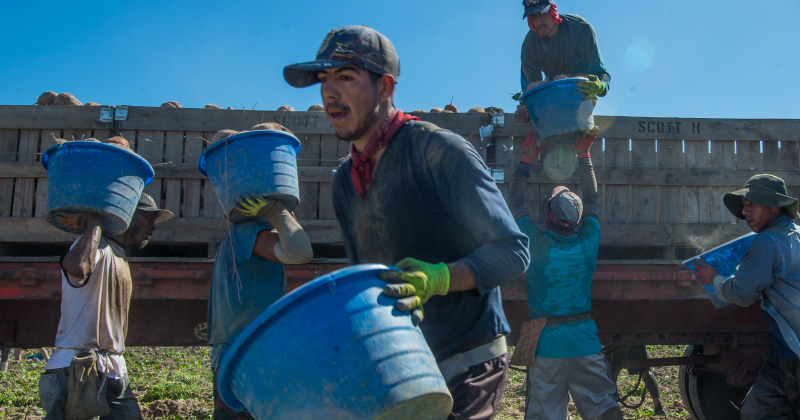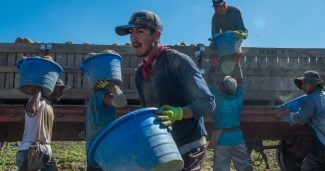MCN’s Liebman and Dr. Madaras: Health Disparities, Barriers Increase Farmworkers’ Risk of COVID-19

On Tuesday, two staff members from Migrant Clinicians Network (MCN) presented to the National Advisory Council on Migrant Health (NACMH) on farmworker health in the midst of the pandemic. The day marked the first of a four-day virtual series for NACMH’s October 2020 meeting. Amy Liebman, MPA, MA, MCN’s Director of Environmental and Occupational Health, and Laszlo Madaras, MD, MPH, SFHM, MCN’s Chief Medical Officer, spoke during the webinar.
Liebman and Dr. Madaras shared MCN’s new guidelines and associated algorithm on farmworker testing for COVID-19 as well as recommendations for post-test support of infected farmworkers and those who have had contact with them. Liebman and Dr. Madaras also detailed other important data concerning the barriers that health centers, health departments, and clinicians face while seeking to serve the health needs of farmworkers during the COVID-19 pandemic and policy measures to overcome these barriers. Liebman and Dr. Madaras, along with Alan Mitchell, Executive Director of HealthEfficient, offered a joint presentation aiming to inform the NACMH of the current health environment of migrants.
The NACMH advises the Secretary of the US Department of Health and Human Services (HHS) and the Health Resources and Services Administration (HRSA) on the environment surrounding health centers that receive migrant health funding. The NACMH is comprised of advisors from a variety of backgrounds, including migrant patients and the clinicians who serve them. Tuesday’s virtual meeting is central to the environment-informing process for NACMH advisors to accurately advise the HHS Secretary and HRSA on policy endeavors.
Opening the presentation, Dr. Madaras presented MCN’s guidelines and algorithm, Protect Agricultural Workers from COVID-19 through Testing and Post-Test Support, which was created by active clinicians, including himself, and is grounded on the information MCN is aware of about COVID-19 as of October 2020. The inspiration for MCN’s guidelines spurs from the frontline experiences of clinicians and the challenges they face in carrying out appropriate clinical and public health measures needed to protect workers and communities from infection.
Additionally, both Liebman and Dr. Madaras mentioned the inaccurate assumptions that are made concerning the causes of outbreaks among migrant workers on farms across the US: “A lot of our migrant communities live in crowded housing. I see that a lot of the blame is put on migrants, saying that it is the lifestyle they live, living in crowded housing [that is the cause of outbreaks],” said Dr. Madaras. However, Dr. Madaras went on to provide a thought-provoking comparison, saying, “it would be like blaming our elderly for living in nursing homes.” Simple analogies such as this one help to clear the fog of confusion that often accompanies the topic of migrant worker outbreaks.
Dr. Madaras noted that the environments migrants are forced to live in during COVID-19 could be improved through farm strategies that include separate housing as well as food and supply deliveries to workers who have been exposed to COVID-19, as explained in the guidelines. While such strategies might seem difficult to achieve, Dr. Madaras, and MCN, argue they are necessary measures if COVID-19 is to be subdued in migrant workplaces. Offering hope for such endeavors, Dr. Madaras discussed his involvement in fighting the spread of cholera, malaria, and meningitis in 1994 in refugee camps in Rwanda. “We did not have a lot of equipment,” said Dr. Madaras, as he presented a photo of refugee patients in Rwanda, “but with good management and proven public health measures, we were able to separate people so they could recover.”
While Dr. Madaras suggested possible housing options, which included those similar to the trailers offered during emergency housing after Hurricane Katrina, as well as the use of community housing, vacant motels, campus dormitories and spaces of otherwise closed institutions, he also discussed other efforts some farms are making to assist their workers with accessing medical care. Dr. Madaras mentioned some farms that acquired Wi-Fi hotspots to make telemedicine available so migrants could receive virtual medical care. Other options from the guidelines included wage relief for workers who are forced to stop working and quicker test results which would allow workers to get back to work as quickly as possible. Dr. Madaras argued that these support opportunities could lessen some migrant farmworkers’ current fears about getting tested. Additionally, Dr. Madaras spoke about the need for providing long-term funding for the creation of a COVID-19 vaccine and stressed the importance of thoroughly testing the vaccine before it is given to the public. He also mentioned that MCN recommends a national testing and vaccine strategy which prioritizes the most at-risk populations.

Liebman continued the presentation, delving deeper into the specific challenges farmworkers, clinicians, health centers, and the larger health community confront during the COVID-19 pandemic and emphasized work as key social determinant of health that drives of COVID-19. “I think it is critical that we understand the difference between racial and ethnic health disparities, and what these people are doing for work,” Liebman stated. While first noting statistics that Latinx and Black communities are multiple times more likely to become infected and to die of a COVID-19, Liebman focused in on the connection between these communities and essential worker status.
In just Latinx households, 64.5% of adults lived in households with at least one worker who was unable to work from home, noted Liebman. “This is a population that experiences numerous vulnerabilities,” she explained, including low wages, health risks of occupation, cultural and language differences, immigration status, migratory lifestyle, and lack of access to health care, among other disparities.
With these kinds of challenges, Liebman went on to explain the barriers farmworkers face, including a long history of “farmworker exceptionalism,” specifically that farmworkers are often excluded from labor rights and health and safety protections that are afforded to other workers. Yet, as Liebman pointed out, these same workers are deemed essential to the US economy.
Liebman took the time to discuss the successes and resourcefulness of community health centers, local health departments, and migrant clinicians throughout the nation, as health centers build on and strengthen their relationships with their communities and local government agencies. Commenting on health centers’ ability to battle potential COVID-19 related disasters, Liebman stated, “the importance of our health care centers being on the front line is so critical.”
Closing out her presentation, Liebman expanded on the importance of the relationships health centers can build as they are on the front lines of COVID-19 in their migrant worker communities. “It really came down to local health agencies and their relationships with the employer,” Liebman said. However, Liebman brought attention to the fact that relationships on the ground can only help to a certain extent. “While I think that some of these partnerships are great, I think they are further fostered when they have temporary standards or emergency executive orders that support them. Regulation is needed,” said Liebman. She explained that temporary policy options are essential right now to protect workers and to help clinicians in their battle against COVID-19 and the barriers they confront. She pointed out that only 11 states have promulgated temporary regulations or emergency orders specific to farmworkers. While these temporary regulatory approaches are needed immediately, in the long run a permanent infectious disease standard, which includes farmworkers, is needed. Liebman noted, testing and safety protocols would be included in the necessary policy initiatives.
Liebman pointed out that including all workers -- “especially those workers at the center, who are needed to keep our economy going,” she said -- would be best practice. “In order for that, we need strong regulations and strong standards in order to protect our farmworkers,” she concluded. In the meantime, MCN is doing its part by helping to bring best practices to frontline clinicians such as its guidelines for migrant worker testing and post-test care. To learn more about MCN’s guidelines and algorithm see this link.
Like what you see? Amplify our collective voice with a contribution.
Got some good news to share? Contact us on our social media pages above.
Return to the main blog page or sign up for blog updates here.
- Log in to post comments





